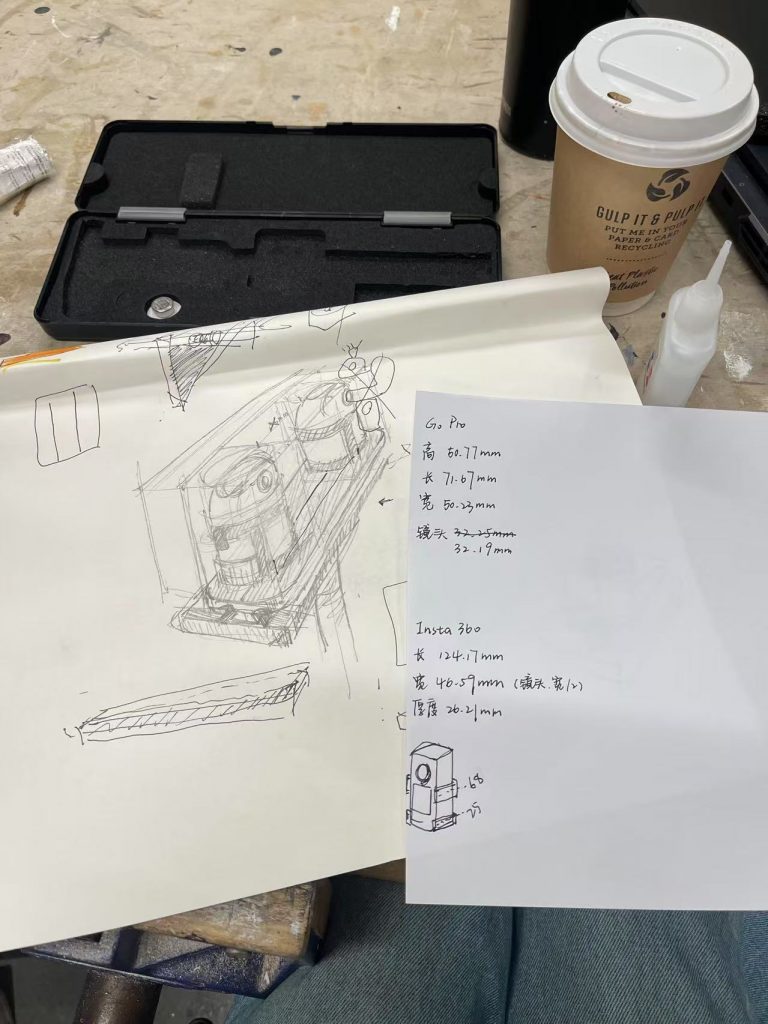Timeline reconstruction






Timeline reconstruction











We decided to use two Insta360 cameras to shoot simultaneously in order to create a 3D effect. We measured the data ourselves, built the model in Rhino, and printed the camera mount at the 3D workshop.
VR 360 VS VR 180
Why Not just shoot 2D?
Comparison of the user experience of two different 180 VR film formats:
Version1
In this format, the viewing distance is fixed. When zooming in or out near the edges of the image, significant distortion occurs, which can lead to visual discomfort. The edges remain visible at all times, and the 3D effect is relatively weak, resulting in a flatter image with reduced comfort and immersion.
Version2
From a distance, this format presents a protruding, roughly 45° “block-like” spatial effect. However, when viewers actively zoom in or move closer, they can effectively pass through a “portal” into the 3D space. This transition makes the boundary far less noticeable, prevents scene distortion, and offers a perceptible sense of entering a new spatial environment. As a result, the Version2 provides a significantly stronger feeling of immersion and is less likely to cause dizziness or motion sickness.
Compared to Version1, the second demonstrates a more immersive and comfortable experience, highlighting the importance of flexible viewing distances and portal-like transitions in immersive 180 VR film design.

This week we traced the path of the Great Fire of 1666 based on documentaries, books, and historical records. This included identifying the fire’s route on historical maps, mapping it onto modern-day maps, and locating key sites along the way.


VR 360 VS VR 180
Why Not just shoot 2D?
Comparison of the user experience of two different 180 VR film formats:
Version1
In this format, the viewing distance is fixed. When zooming in or out near the edges of the image, significant distortion occurs, which can lead to visual discomfort. The edges remain visible at all times, and the 3D effect is relatively weak, resulting in a flatter image with reduced comfort and immersion.
Version2
From a distance, this format presents a protruding, roughly 45° “block-like” spatial effect. However, when viewers actively zoom in or move closer, they can effectively pass through a “portal” into the 3D space. This transition makes the boundary far less noticeable, prevents scene distortion, and offers a perceptible sense of entering a new spatial environment. As a result, the Version2 provides a significantly stronger feeling of immersion and is less likely to cause dizziness or motion sickness.
Compared to Version1, the second demonstrates a more immersive and comfortable experience, highlighting the importance of flexible viewing distances and portal-like transitions in immersive 180 VR film design.

Concept:
What if you could stand in the middle of a modern-day London street and watch history unfold around you? This project takes you on a journey that blends the past and present into one immersive experience.
It begins with a 360-degree video, combining live-action footage of today’s iconic London locations with stunning point-cloud animation. The animation, derived from scans of the actual places, overlays fragments of history onto the present, creating a dreamlike mix of what once was and what is now. Imagine standing on Tower Hill, seeing the vibrant modern city around you while ghostly outlines of the ancient Roman wall rise up in point-cloud form, hinting at the past lives of this space.
Then comes the second part: a fully interactive VR experience where you step directly into history. Picture this—Pudding Lane during the Great Fire of London, or the Globe Theatre as actors rehearse one of Shakespeare’s plays. This isn’t just a static scene: you can walk around, explore, and interact with objects or characters to uncover hidden stories. The VR portion doesn’t just show you history—it places you right at its heart.
This dual approach—mixing video and animation to set the scene, and VR immersion to dive deeper—makes history not only educational but deeply personal. Whether we explore the fire, the Blitz, or something else, this experience transforms London into a living, breathing storybook.
Structure of the Experience
Target Audiences:
History and Documentary Lovers
Global Museum and Cultural Institutions
Tourists and Visitors to London
Educators and Students
International Fans of London’s Pop Culture and Literature
What’s the genre?
Educational VR focuses on recreating the timeline of the Great Fire of London, emphasizing the events and locations while educating people about the historical facts.

Time Period: 1666
The fire began in the early hours of September 2 and burned uncontrollably for four days, finally being contained on September 6.
Location:
Pudding Lane, City of London
The fire started in a bakery owned by Thomas Farriner and quickly spread across the densely populated area of central London, devastating homes, businesses, and landmarks.
Historical Significance:
The Great Fire of London was a transformative event in the city’s history. It destroyed over 13,000 homes, 87 parish churches, and iconic structures like St. Paul’s Cathedral. It marked the end of medieval London and paved the way for modern urban planning and fire safety measures, including the widespread use of brick and stone in rebuilding efforts. Sir Christopher Wren’s redesign of St. Paul’s Cathedral became a symbol of the city’s resilience and rebirth.
Visual Potential:
This event offers dramatic visual storytelling possibilities:
Interactive Opportunities
Challenges or Constraints: